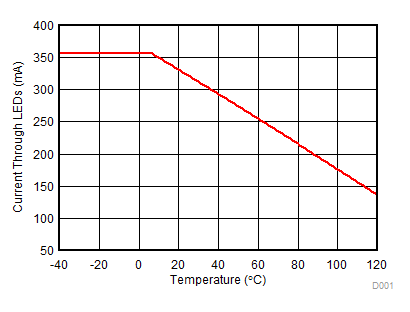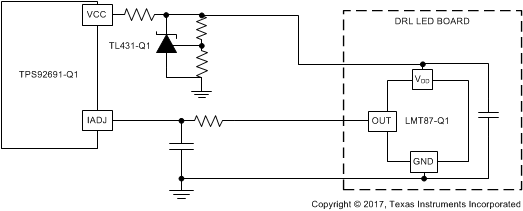TIDUCL3 February 2017
- 1 Overview
- 2 Resources
- 3 Features
- 4 Applications
- 5 Design Images
- 6 System Overview
-
7 System Design Theory
- 7.1 PCB and Form Factor
- 7.2 Optimizing Board Performance Based on LED String Voltage and Current
- 7.3 Switching Frequency
- 7.4 Output Overvoltage Protection (OVP)
- 7.5 Current Monitoring (IMON)
- 7.6 Thermal Foldback
- 7.7 Clock Generation (PWM)
- 7.8 Onboard Supply and Setting Duty Cycle
- 7.9 Buffering, Averaging, and Filtering
- 7.10 Boost Converter
- 8 Getting Started Hardware
- 9 Testing and Results
- 10Design Files
- 11Related Documentation
- 12About the Author
7.6 Thermal Foldback
Temperature is a concern when driving the DRL LEDs at high currents in an automotive environment. Take care at high temperatures so as to not exceed the LED operating temperature requirements. For this reason, the current going through the LEDs must be decreased when the LED temperature begins to increase in order to cool down the LEDs before they are damaged. The way this is done is by using the LMT87-Q1 TI Temperature Sensor fed into the "IADJ" pin of the TPS92691-Q1. The output of the LMT87-Q1 is approximately modeled as Equation 4.

Where V is the output voltage and T is the temperature. Find more information about the output of the LMT87-Q1 at its product page.
The "IADJ" pin of the TPS92691-Q1 acts as a current limiter for the LEDs. The output current going through the LEDs is read by shunting R26 in Figure 22 to the current sense amplifier, "CSP" and "CSN". This voltage drop, V(CSP-CSN), is amplified by a voltage-gain factor of 14, which is internally forced to the "IADJ" pin voltage. Therefore, to force a current through the LEDs, the "IADJ" pin voltage is divided by 14 and then divided by R26 as shown in Equation 7. The equation for temperature and current is shown in Equation 8.




Equation 8 is obtained by substituting Equation 4 into Equation 7. In this TI Design, R26 is chosen to be 560 mΩ. This means that the relationship of current through the LEDs versus temperature looks like Figure 8.
 Figure 8. Current Through LEDs versus Temperature
Figure 8. Current Through LEDs versus Temperature Note that current is a first-order representation of the brightness of the LEDs, which is what is needed to be controlled for this TI Design. Find more information about the LED selection and some of the difficulties in Section 8.2. Also the LMT87-Q1 is measuring the ambient temperature of the LED board. Therefore, because the junction temperature of the LEDs is the specification that could be violated, analysis must be done to determine the relationship between the ambient temperature where the LMT87-Q1 and the junction temperature of each of the LEDs so that the thermal foldback will not allow them to go beyond the maximum junction temperature. This relationship is application specific because it is dependent on a number of factors such as distance, copper thickness, heat sinks of LEDs, power dissipated through the LEDs, and so on. This calculation would also have to be done if thermal foldback was implemented with NTCs. However, with NTCs not being linear, even more complicated math would be needed to determine the ambient temperature, while the LMT87-Q1 can just be fed back into the driving device.
For this TI Design, the basic circuitry to implement thermal foldback was used as shown in Figure 9.
 Figure 9. TIDA-01382 Thermal Foldback Circuit
Figure 9. TIDA-01382 Thermal Foldback Circuit